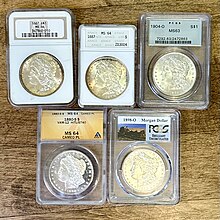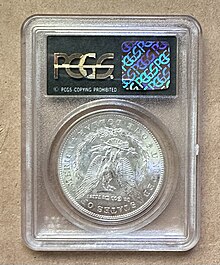


Coin slab is a type of holder for a coin. Slabbed coins are typically from one of the coin grading companies. The practice of sending coins to third-party grading companies and then "slabbing" them began in 1986.
When a grading company grades the coin it is sealed in a tamper proof slab with a barcode and a hologram. To prevent counterfeiting, holograms were attached to the graded coin slabs beginning in 1989. The early coin slabs did not have a hologram.

Slabbing coins is a practice which began in 1986. It was a way to remove coin grading controversies by having a third party certify the coin's condition.[1] There are major coin certification companies that encapsulate coins in an acrylic case after grading the coin. Companies like ANACS, Numismatic Guaranty Company (NGC), Professional Coin Grading Service (PCGS), International Coin Certification Service and CAC accept coins which they grade, certify and then slab. Collectors rely on these third party grading companies to certify coins.[2] After the coins are reviewed and certified a holographic label is attached to the slab.[3][4] The earliest coins that were slabbed by the major coin grading companies did not have holograms. PCGS began adding a hologram to the reverse of their holders in 1989.[5] NGC began adding a hologram to their coin slabs in 1990.[6]
Counterfeiters have duplicated some slabs from major grading companies. In 2023, CoinWeek reported counterfeit 1881 CC Morgan dollar “PCGS” slabs.[7][8] In 2018, Coin World numismatic magazine reported that counterfeit PCGS slabs complete with holograms were being sold on the website AliExpress. They reported that the real slabs are "sonically sealed" but fake slabs snap together.[9] The magazine also reported the discovery of a fake South African gold Krugerrand which was in a counterfeit NGC slab with a hologram.[10]
|
| |||||||||
|---|---|---|---|---|---|---|---|---|---|
| Numismatics |
| ||||||||
| Grading |
| ||||||||
| Supplies |
| ||||||||
| Other |
| ||||||||